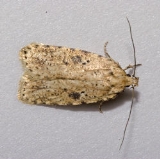
Agonopterix arenella
Encyclopedia
Agonopterix arenella is a species of moth
of the family Oecophoridae
. It is found in all of Europe
, except the Iberian Peninsula
.
The wingspan
is 19-23 mm.
The larvae feed on Arctium lappa, Carduus
, Carlina
, Centaurea jacea
, Centaurea nigra
, Centaurea scabiosa
, Cirsium vulgare
, Knautia
, Serratula tinctoria
and Sonchus
. They mine
the leaves of their host plant. The mine has the form of a short full depth corridor. The larva soon vacates the mine, creating a spinning at the leaf underside, from where it causes window feeding. Larvae can be found from May to early August. They are pale green or yellowish with a pale brown or yellowish head.
Moth
A moth is an insect closely related to the butterfly, both being of the order Lepidoptera. Moths form the majority of this order; there are thought to be 150,000 to 250,000 different species of moth , with thousands of species yet to be described...
of the family Oecophoridae
Oecophoridae
Oecophoridae is a family of small moths in the superfamily Gelechioidea. The phylogeny and systematics of gelechoid moths are still not fully resolved, and the circumscription of the Oecophoridae is strongly affected by this....
. It is found in all of Europe
Europe
Europe is, by convention, one of the world's seven continents. Comprising the westernmost peninsula of Eurasia, Europe is generally 'divided' from Asia to its east by the watershed divides of the Ural and Caucasus Mountains, the Ural River, the Caspian and Black Seas, and the waterways connecting...
, except the Iberian Peninsula
Iberian Peninsula
The Iberian Peninsula , sometimes called Iberia, is located in the extreme southwest of Europe and includes the modern-day sovereign states of Spain, Portugal and Andorra, as well as the British Overseas Territory of Gibraltar...
.
The wingspan
Wingspan
The wingspan of an airplane or a bird, is the distance from one wingtip to the other wingtip. For example, the Boeing 777 has a wingspan of about ; and a Wandering Albatross caught in 1965 had a wingspan of , the official record for a living bird.The term wingspan, more technically extent, is...
is 19-23 mm.
The larvae feed on Arctium lappa, Carduus
Carduus
Carduus is a genus of about 90 species of thistles in the family Asteraceae, native to Europe, Asia and Africa. Carduus is Latin for a thistle....
, Carlina
Carlina
Carlina is a genus of about 30 species of thistles in the family Asteraceae, native to Europe, north Africa and Asia. The highest species diversity in the Mediterranean region, and only one species Carlina (carline thistle) is a genus of about 30 species of thistles in the family Asteraceae,...
, Centaurea jacea
Centaurea jacea
Centaurea jacea is a species of herbaceous perennial plants in the genus Centaurea native to dry meadows and open woodland throughout Europe...
, Centaurea nigra
Centaurea nigra
Centaurea nigra is a species of flowering plant in the daisy family known by the common names Lesser Knapweed, Common Knapweed and Black Knapweed...
, Centaurea scabiosa
Centaurea scabiosa
Centaurea scabiosa or Greater Knapweed is a perennial plant of the genus Centaurea. It is native to Europe and bears purple flower heads.Greater knapweed is found growing in dry grasslands, hedgerows and cliffs on lime-rich soil...
, Cirsium vulgare
Cirsium vulgare
Cirsium vulgare is a species of the genus Cirsium, native throughout most of Europe , western Asia , and northwestern Africa...
, Knautia
Knautia
Knautia is a genus in the family Dipsacaceae. The common names of these flowers are a variant of "widow flower." Others are given the name "Scabious," although this word belongs to a related genus .Species include:...
, Serratula tinctoria
Serratula tinctoria
Serratula tinctoria, commonly known as Saw-wort, is a species in the genus Serratula. It is a native of Europe. It grows in moist soil, full sun to part shade, and grows up to one meter tall....
and Sonchus
Sonchus
Sonchus is a genus of flowering plants in the daisy family Asteraceae. Most of the species are annual herbs, a few are perennial, and some are even woody...
. They mine
Leaf miner
Leaf miner is a term used to describe the larvae of many different species of insect which live in and eat the leaf tissue of plants. The vast majority of leaf-mining insects are moths , sawflies and flies , though some beetles and wasps also exhibit this behavior.Like Woodboring beetles, leaf...
the leaves of their host plant. The mine has the form of a short full depth corridor. The larva soon vacates the mine, creating a spinning at the leaf underside, from where it causes window feeding. Larvae can be found from May to early August. They are pale green or yellowish with a pale brown or yellowish head.

